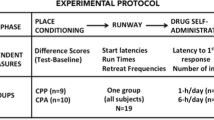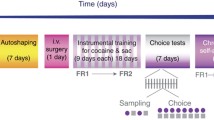Abstract
The conditioned place preference (CPP) paradigm is used widely as a measure of a drug's rewarding properties. The present study examined whether the CPP produced by amphetamine is dependent on the locomotor stimulation that is produced by the drug. An earlier study (Swerdlow and Koob 1984) found that interfering with loomotor stimulation using restraint during the drug treatment blocked CPP. The present study examined whether this effect of restraint was indeed due to restriction of locomotion or was due to restraint maintaining the stimulus novelty of the CPP apparatus. The first experiment showed that novelty of the apparatus itself was a potent factor in the CPP paradigm and was capable of producing a place preference. The second experiment showed that restraint alone could produce a CPP, as would be expected if it maintained stimulus novelty of the apparatus. It also showed that although a CPP to amphetamine could be blocked by restraining the animals during drug treatment, prior habituation to the apparatus to reduce stimulus novelty before treatment negated the effect of restraint on amphetamine CPP. These results indicate that rats can demonstrate a CPP produced by amphetamine even when their activity is restrained. This suggests that the drug's rewarding properties are not dependent on locomotor stimulation.
Similar content being viewed by others
References
Carr GD, White NM (1983) Conditioned place preference from intra-accumbens but not intra-caudate amphetamine injections. Life Sci 33:2551–2557
Di Scala G, Martin-Iverson MT, Phillips AG, Fibiger HC (1985) The effects of progabide (SL 7600Z) on locomotor activity and conditioned place preference induced by d-amphetamine. Eur J Pharmacol 107:271–274
Gunne LM, Anggard E, Jonsson LE (1972) Clinical trials with amphetamine-blocking drugs. Psychiatr Neurol Neurochir 75:225–226
Hebb DO, Makut H (1955) Motivation et recherche du changement perceptif chez le rat et chez l'homme. J Psychol Norm Pathol 48:209–221
Kelly PH (1977) Drug-induced motor behavior. In: Iversen LL, Iversen SD, Snyder SH (eds) Handbook of psychopharmacology, Vol 8. Plenum Press, New York, pp 295–331
Kumar R (1972) Morphine dependence in rats: secondary reinforcement from environmental stimuli. Psychopharmacologia 25:332–338
Mithani S, Martin-Iverson MT, Phillips AG, Fibiger HC (1986) The effects of haloperidol on amphetamine- and methylphenidate-induced conditioned place preferences and locomotor activity, Psychopharmacology 90:247–252
Mucha RF, Iversen SD (1984) Reinforcing properties of morphine and naloxone revealed by conditioned place preferences: a procedural examination. Psychopharmacology 82:241–247
Pickens R, Harris WC (1968) Self-administration of d-amphetamine by rats. Psychopharmacologia 12:158–163
Reicher MA, Holman EW (1977) Location preference and flavour aversion reinforced by amphetamine in rats. Anim Learn Behav 5:343–346
Rossi NA, Reid LD (1976) Affective states associated with morphine injections. Physiol Psychol 4:269–274
Schenck S, Hunt T, Colle L, Amit Z (1983) Isolation versus grouped housing in rats: differential effects of low doses of heroin in the place preference paradigm. Life Sci 32:1129–1134
Seiden LS, Dykstra LA (1977) Psychopharmacology. Van Nostrand Reinhold, New York
Spyraki C, Fibiger HC, Phillips AG (1982) Dopaminergic substrates of amphetamine-induced place preference conditioning. Brain Res 253:185–193
Swerdlow NR, Koob GF (1984) Restrained rats learn amphetamine-conditioned locomotion, but not place preference. Psychopharmacology 84:163–166
Van Der Kooy D, Swerdlow NR, Koob GF (1983) Paradoxical reinforcing properties of apomorphine: effects of nucleus accumbens and area postrema lesions. Brain Res 259:111–118
Zimbardo PG, Montgomery KD (1957) The relative strengths of consummatory responses in hunger, thirst and exploratory drive. J Comp Psychol 50:504–508
Author information
Authors and Affiliations
Additional information
Offprint requests to: G.D. Carr
Rights and permissions
About this article
Cite this article
Carr, G.D., Phillips, A.G. & Fibiger, H.C. Independence of amphetamine reward from locomotor stimulation demonstrated by conditioned place preference. Psychopharmacology 94, 221–226 (1988). https://doi.org/10.1007/BF00176849
Received:
Revised:
Issue Date:
DOI: https://doi.org/10.1007/BF00176849




